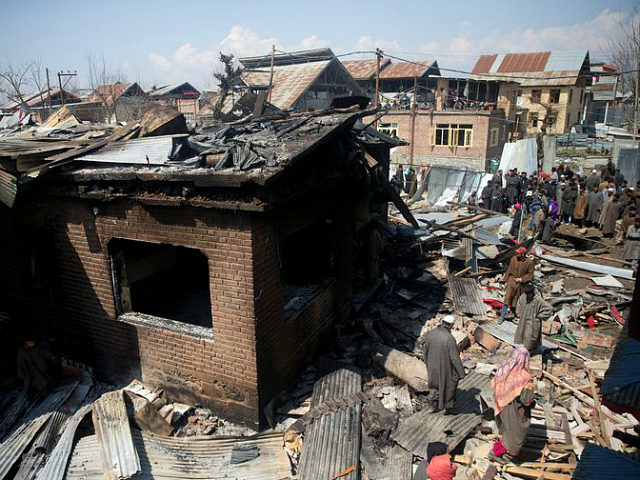Tensions between nuclear-armed regional foes New Delhi and Islamabad have intensified in recent days, triggering more deadly clashes in the disputed Himalayan region of Kashmir and prompting the Indian Air Force to scramble its Mirage 2000 and Sukhoi Su-30 warplanes to tackle four F-16 jets flown by Pakistan near their mutual border.
The militaries of both India and Pakistan are reportedly on high alert in the wake of the February 14 attack in New Delhi-administered Kashmir that drove both countries to the brink of an all-out war, with the two nations even engaging reciprocal air operations, including a brief dogfight.
Both countries have reportedly boosted their military presence along their international border.
Despite a 2003 ceasefire, India and Pakistan constantly clash along the separate unofficial border that splits Kashmir in half — the New Delhi administered territory and the Pakistan-held region.
Both countries, which have already fought two major wars and a minor conflict over the region, claim ownership of Kashmir in its entirety. Pakistan has ceded control of some of its territories to its ally China, while India disputes Beijing’s occupation of land it holds in Kashmir.
CBS News reports:
Seven people have been killed and 28 injured in two days of small arms fire and shelling between Indian and Pakistani forces. The renewed clashes have taken place along the de-facto border that divides the Kashmir region in half. … This week has seen the deadliest border escalation between the nuclear-armed neighbors since they carried out airstrikes on each other’s territory near the end of February.
The CBS News report covers casualties stemming from confrontations on just Monday and Tuesday along the unofficial border dividing Kashmir, known as the Line of Control (LOC).
Among the casualties are members of the Indian and Pakistani security forces and civilians, including a 5-year-old girl and a woman.
“The crossfire incidents have increased since the February airstrikes, claiming dozens of lives and displacing scores of people from the border areas on both sides,” CBS News points out. “The tension has escalated in recent weeks as India is just days away from a crucial national election in which Prime Minister Narendra Modi is seeking a second term.”
Heavy firing and shelling along the LOC continued into Tuesday night, injuring an additional five people in New Delhi-held Kashmir’s Poonch district, including two children, two women, and an Indian soldier, not covered by CBS News’ count, according to India’s News18.
In a separate incident along the India-Pakistan international border, which also straddles the disputed Kashmir region, the Indian military deployed some of its fighter jets to confront Pakistani warplanes.
India’s Business Today reports:
Indian Air Force scrambled its Mirage 2000 and Sukhoi Su-30 jets last night to tackle a package of Pakistan Air Force’s four F-16 jets close to the international border near [India’s] Punjab [region]. It is unclear whether the Pakistani fighter jets were trying to invade the Indian airspace. The planes from Indian side were scrambled as soon as aerial activity was detected on radars.
Both New Delhi and Islamabad have reportedly begun beefing up their military presence at and around their international border below the Kashmir region, near India’s Punjab and Rajasthan areas.
On March 30, India’s Zee News noted:
Indian Army has begun massive mobilization of military tanks and deployment of troops along the International Border in Rajasthan and Punjab. … The development comes amid reports of Pakistan vacating civilians at border villages and moving large scale troops to the Indian front. Sources also claimed that the Pakistan Army moved troops opposite ‘sensitive areas’ in Amritsar and Samba sectors along the International Border.
Zee News acknowledged that “tensions have been simmering” between India and Pakistan since the Valentine’s Day attack claimed by the Pakistan-based Jaish-e-Mohammad (JeM), a U.S.-designated terrorist group.
New Delhi also deployed reinforcements to Kashmir after the February 14 attack.
Despite the JEM claiming responsibility for the attack and evidence of its involvement provided to Pakistan by India, Islamabad denies that the group is connected to the incident that left more than 40 Indian security forces dead, marking one of the deadliest assaults in Kashmir. Pakistan and China have blocked U.S.-backed efforts in the United Nations to label JEM leader Masood Azhar a global terrorist.
Pakistan insists it does not harbor terrorists despite U.S., India, and Afghanistan claims to the contrary. The United States recently credited Islamabad with taking action against local terrorists, but India argues its insufficient.
The Indian military has intensified counterterrorism operations in Pulwama, home to the heinous Valentine’s Day attack.
Citing Col. Rajesh Kalia, a spokesman for the Indian military, NDTV reports, “Four Lashkar-e-Taiba [LeT] terrorists have been killed in an anti-terror operation in Jammu and Kashmir’s Pulwama district. Three security personnel were also injured in the operation in the south Kashmir district.”
The overnight operation came a day after alleged terrorists launched a grenade attack, injuring a member of India’s security force.
LeT is a JEM ally that the United States has also designated as an anti-India terrorist group based in Pakistan.
More than 500 casualties in Indian-administered Kashmir alone made 2018 the bloodiest year in the region in nearly a decade.

COMMENTS
Please let us know if you're having issues with commenting.